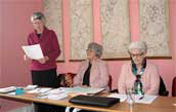The Jacobean paintings were discovered in 1954 in the upper storey of 20 High Sreet North, Dunstable, a 16th century Tudor building. It is thought the paintings were executed about 1600, probably by a journeyman mural painter working up and down the towns on the old Watling Street, possibly working mainly for inns along the old road.
WHITE HART INN
Extensive research has revealed that the building was once an inn, known as the White Hart. It was built round about 1600 and there is an almost complete series of deeds still in existence charting its history from then until the present day. The inn closed in about 1780 and became a private house and an inn of the same name opened a bit further along the road. In the 19th century the house was occupied, together with the house next door, by a hat manufacturer, and in the 20th century it became a shop, famous eventually as the cycle shop belonging to Charlie Cole, who discovered the paintings by accident when some coverings were removed.
NATIONWIDE BUILDING SOCIETY
When the premises were substantially renovated for the present branch of the Nationwide Building Society, a supreme effort was made to preserve the paintings. Thirteen panels have amazingly survived and are now on display in the Meeting Room at Priory House.
HUNTING SCENE
Six of the panels depict a hunting scene and of these the most remarkable is that of a portrait of a man in Tudor costume smoking a clay pipe. This could well be one of the earliest depictions of tobacco smoking in the country, making the paintings not only locally important but also nationally significant!
FURTHER WORK
In 2013 further conservation work was undertaken to preserve these precious artefacts as part of Dunstable’s heritage and they were all covered with museum-grade, non-reflective, UV resistant acrylic to allow the general public access to view these treasures for themselves.



